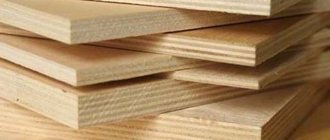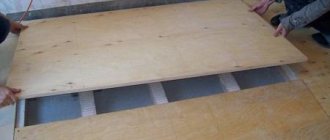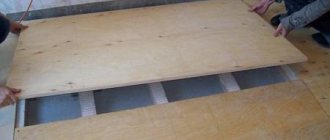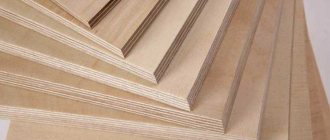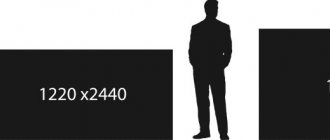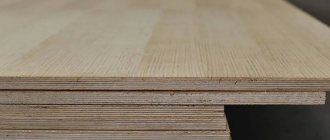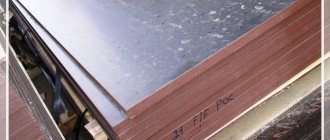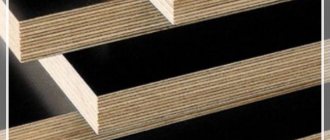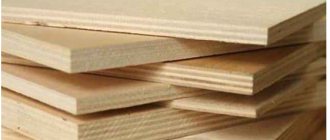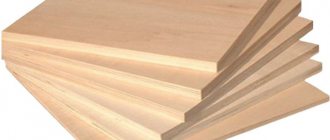Plywood 3 mm
Plywood 3 mm thick is produced only from birch veneer. In accordance with GOST, it consists of 3 layers of veneer. There are brands FK, FSF and aviation, but the latter is extremely rare and is used almost exclusively in aircraft modeling. FC plywood with a thickness of 3 mm can be used for the manufacture of toys and souvenirs, as well as for cladding ceilings in residential premises - usually in country houses or change houses. FSF plywood can be used for the manufacture of lightweight packaging boxes and cladding ceilings in utility rooms.
Why sizes matter
The scope of application of plywood is very wide - from construction and finishing works to the manufacture of furniture and home accessories. For each purpose you need to choose the right sheets. And the decisive factor here is thickness. The minimum number of layers is 3 (thickness 3 mm), maximum - 21 (thickness 30-40 mm). Intermediate values are always odd - this rule is observed by manufacturers to improve the mechanical strength of the material.
Variety of plywood in thickness and number of layers
The length and width of the sheet or slab are selected for ease of use: small-sized ones are easier to move and install, and with larger fragments the process goes faster. It is also recommended to compare the size of plywood with the area to be covered and choose the option that will leave less waste.
Plywood 6 and 6.5 mm thick.
According to GOSTs, it should have a thickness of 6.5 mm, but 6 mm thick is often found on sale. Birch is made from 5 layers of veneer, hardwood - from 3.
FC plywood with a thickness of 6.5 mm is used for cladding ceilings, walls and partitions in residential premises, making furniture, toys, souvenirs and modeling. Grade 3 and 4 plywood can be used to make packing crates.
FSF plywood 6 mm thick is used in the production of garden furniture, packaging boxes for non-food products, as well as cladding walls and ceilings in non-residential premises.
Standard and custom sizes
Standard plywood formats are sheets of width 1220 and 1525, length from 1525 to 2500 mm. The most common sizes are 1525x1525 and 1220x2440. They are in great demand due to their ease of operation and transportation. Large format or non-standard sheets are available in widths of 1220, 1500 and 1525 mm, while their length can reach 3660 mm. These dimensions should be used when finishing large areas or for production needs.
Large format and standard plywood
Dimensions and maximum deviation from them are regulated by the state standard for general purpose plywood (GOST 3916.1-96 for hardwood and GOST 3916.2-96 for coniferous wood). The standard provides for the possibility of producing sheets of any size to order.
| Sheet length in mm | Permissible deviation (+/-) in mm |
| 1200-1250 | 3 |
| 1500-1830 | 4 |
| 2100-2500 | 4 |
| 2700-3660 | 5 |
Plywood 15 mm thick
Coniferous is made from 7 layers of veneer, hardwood - from 11. It is used in the same way as 12 mm thick plywood, but it is no longer practical to cover the ceilings of walls with it from the inside - it is too thick and too expensive. It is also too expensive for laying on joists in 2 layers, and not strong enough for laying in 1 layer. 15mm plywood can also be used as formwork when pouring small foundations - for example, a fence foundation - but you must ensure that it has sufficient rigidity so that the formwork will not bend under the pressure of the concrete.
What are the methods for laying parquet boards and block parquet on plywood?
- The floating method involves the following laying technology: parquet blocks are simply laid on plywood. Since the joints and grooves of the segments coincide, the parquet will not “move apart” and bubble. Such parquet is easy to disassemble and reassemble if necessary, and replace a couple of boards in case of breakage. But! This method is quite suitable for parquet boards, but in the case of block parquet it is better not to use it: such dies are too small to stay level and firmly only due to mechanical adhesion. Block parquet requires glue.
- The glue method is as follows: first, sheets of plywood are laid with a small gap from each other, then attached to the base with dowels and screws. Then a special parquet adhesive is applied to the plywood. They let him dry. Parquet is laid on top of the glue. It is also necessary to coat the grooves and joints with glue.
The adhesive method is much more reliable than the floating method; it provides stronger adhesion of the parquet to the plywood, which means the floor is more even and does not creak or bubble.
So, is it possible to lay parquet flooring without plywood? It is possible, but only if you are dealing with a perfectly flat, sound-insulated base. Otherwise, this may affect the quality of the coating and will lead to the fact that, in the worst case, you will be forced to re-lay the parquet. So if it is possible to lay plywood under the parquet, then it is better to do so. Yes, this will require additional costs for the plywood itself, and for glue, and for the work of craftsmen (or it will take more of your time if you do everything yourself). But this will save you from the need for alterations and allow you to enjoy a smooth, warm parquet floor. We recommend reading the article on how to lay parquet yourself.
Plywood thickness 18, 20 and 21 mm
Birch plywood with a thickness of 18 mm is made of 13 layers of veneer, and birch plywood with a thickness of 21 mm is made of 15 layers.
Coniferous plywood with a thickness of 18 and 21 mm consists of 9 layers of veneer. This kind of plywood is rarely used for making toys and souvenirs - it has excessive strength and is too expensive. But this is the most popular formwork slab - its strength and rigidity are enough to fill almost any structure in low-rise construction and many in capital construction. In addition, FC birch plywood with a thickness of 21 mm is used as a subfloor when laid along joists - with a joist pitch of 600 mm or less, its strength is sufficient. FSF plywood of this thickness makes excellent roofing decking for ceramic or cement-sand tiles. In addition, FSF plywood is often used for the construction of children's playgrounds in kindergartens, primary schools, summer camps, in local areas, etc.
Where is it usually used?
Plywood, a material of universal value. For this reason, it is used in a wide variety of fields and areas. Plywood sheets can be used for repairs, laying floors, cladding facades and walls.
Often, plywood sheets become indispensable when carrying out roofing work and arranging formwork.
In addition to these areas, plywood, especially thin plywood, is used in various other areas, for example:
- In the manufacture of souvenirs.
- In instrument engineering.
- Various musical instruments are often made from plywood.
- Also, such plywood products are indispensable in furniture production, for example, they are used to line cabinets, cabinets, etc.
- In addition, plywood sheets are used in various design solutions both indoors and outdoors.
- They are almost always used to pack containers when transporting equipment and other things.
- In finishing work and, of course, in aircraft construction, which is why it is often called aviation.
Typically, thin products mean a product with a thickness of 0.4 to 6 mm. And although a material of such thickness is not capable of independently bearing increased loads and operating in these conditions, it still remains indispensable in many industries.
Plywood thickness 24 and 27 mm
Coniferous plywood with a thickness of 24 and 27 mm is made of 11 layers of veneer, birch plywood with a thickness of 24 mm is made of 17 layers of veneer, 27 mm is made of 19 layers of veneer. This is a very durable and quite expensive plywood. It is used for:
- production of high-strength formwork panels (FC, FSF and laminated, depending on the required number of revolutions);
- laying floors on joists (FC in residential premises, FSF in rooms with high humidity);
- flooring in transport (special laminated transport plywood);
- covering the sides of trucks and trailers (FSF plywood);
- construction of concert, sports and children's playgrounds (FC, FSF and laminated depending on the task).
Laying plywood on the floor on joists: sequence of actions
In general, it is quite difficult to fully describe the technology - there may be too many details. We will describe only the main steps and stages. This is the order in which you need to lay the plywood floor along the joists.
- Removing the old floor to a solid base. Removing debris, cleaning the base with a vacuum cleaner.
- Assembling the grille and leveling it.
- Attaching the joists/grids to the base.
- Installation of plywood on joists.
In general, that's all. But there can be many particulars. For example, if there are significant differences in the foundation (holes or humps), then it is better to seal them. It will be easier to set according to the log level. Second point. In high-rise buildings, it is often recommended to spread film over concrete tiles as waterproofing.
How to attach plywood to a wood floor. Through self-tapping screws, but you can also pre-apply a layer of mastic for gluing wood
This can be done, but this is not a guarantee that in the event of a flood you will not flood your neighbors below. You will have to violate the integrity of the film when attaching the sheathing. And water, as you know, will find a hole. If you are really concerned about this issue, it is better to cover the concrete slab with liquid waterproofing. But then it must be applied to the walls - exactly to the level of the finished floor. That's right - using coating waterproofing, it is better to treat the flooring in the kitchen or bathroom. It's more reliable.
Plywood thickness 30, 35 and 40 mm
Birch plywood 30 mm thick is made of 21 layers of veneer, coniferous plywood is made of 13 layers. Plywood with a thickness of 35 and 40 mm is not described in GOST, and therefore the number of layers in it is not regulated.
A slab of this thickness and strength is used mainly for:
- production of formwork panels;
- production of flooring for scaffolding;
- laying on the floor in transport;
- construction of sports facilities and playgrounds;
- manufacturing table tops for installing small machines.
Acceptance, quality control
Each batch of wooden plywood is accepted according to the following criteria:
Plywood comes in 1-4 grades.
- each batch must be documented in only one document including all necessary data;
- sheets of general purpose products are checked selectively with control of strength, size and number of layers;
- the concentration of formaldehyde in plywood must be within sanitary and environmental standards;
- General purpose plywood should not contain veneer delamination or bubbles;
- humidity must comply with GOST 9621;
- the roughness of the outer surface must comply with the requirements of GOST 15612;
- The sound absorption coefficient must comply with GOST 16297, the factory hardness should not deviate from GOST 9627.1, and the thermal conductivity GOST 7076.
The product must be transported in closed transport. Transportation is carried out taking into account all transportation rules applicable to each type of transport separately. Storage is carried out on pallets only in a horizontal position in closed warehouses at temperatures from -40C to +50C and humidity not more than 85%. The warranty period is within 3-6 years.
In summing up, I would like to note that if there are high requirements for the durability of this material, it is recommended to use high-strength laminated plywood.
Where to buy plywood for formwork in Yekaterinburg?
TK FrontStroy LLC offers organizations and private clients in the region a wide range of construction products and components. From us you can not only buy 18, 15, 12, 9 and 6 mm plywood, but also get interesting terms of cooperation. Advantages of ordering building materials from us:
- more than 5 years of experience in the market of Yekaterinburg and the Sverdlovsk region;
- online catalog with current prices;
- strict certification system;
- consultations, individual approach, discounts.
Not all companies for the procurement and sale of plywood offer such flexible conditions for the buyer as FrontStroy. We are always ready for dialogue. Found lower prices? Let us know and our company will offer you personal pricing conditions!
How much can you buy laminated plywood for?
[rek_custom3]
To buy plywood in Moscow, moisture-resistant or regular, you should focus on the average prices of the most commonly purchased laminated material. The price of a sheet measuring 2440x1220x12 mm will be approximately 1280 rubles.
Bekelized plywood is fire and moisture resistant, and is not afraid of sudden temperature changes. This material is relatively new, but has already proven itself well and is loved by consumers for its strength, which is close to low-alloy steel. The production uses pine or birch veneer impregnated with bekelite resin. Service life is at least 10 years. It is used in construction for the manufacture of formwork of various designs. Plywood has a high price; you need to pay at least 1,290 rubles per sheet.
Watch and be inspired
Plywood is a phenomenally flexible material.
Take a look at what wonderful things craftsmen create from seemingly simple pieces of wood:
